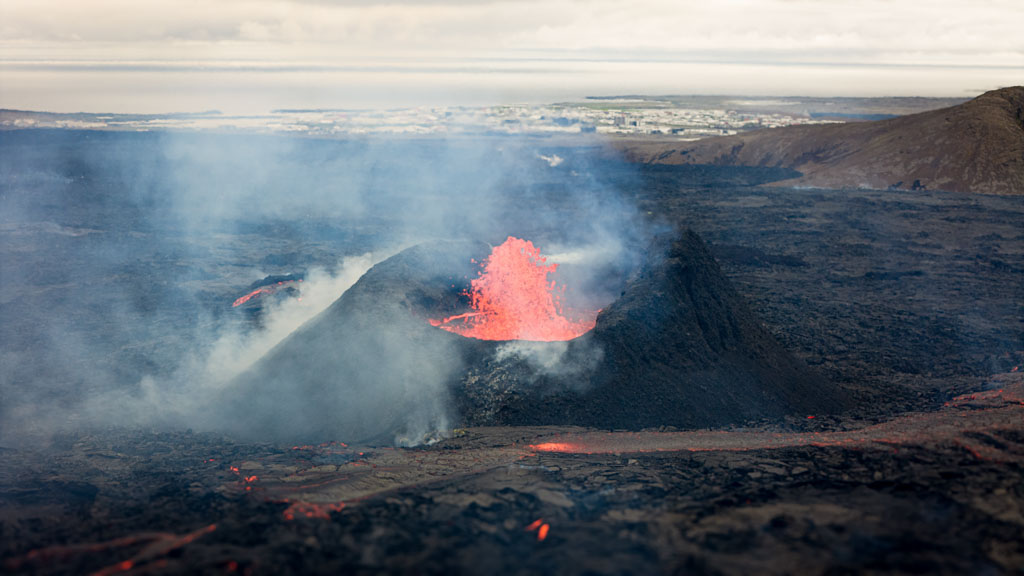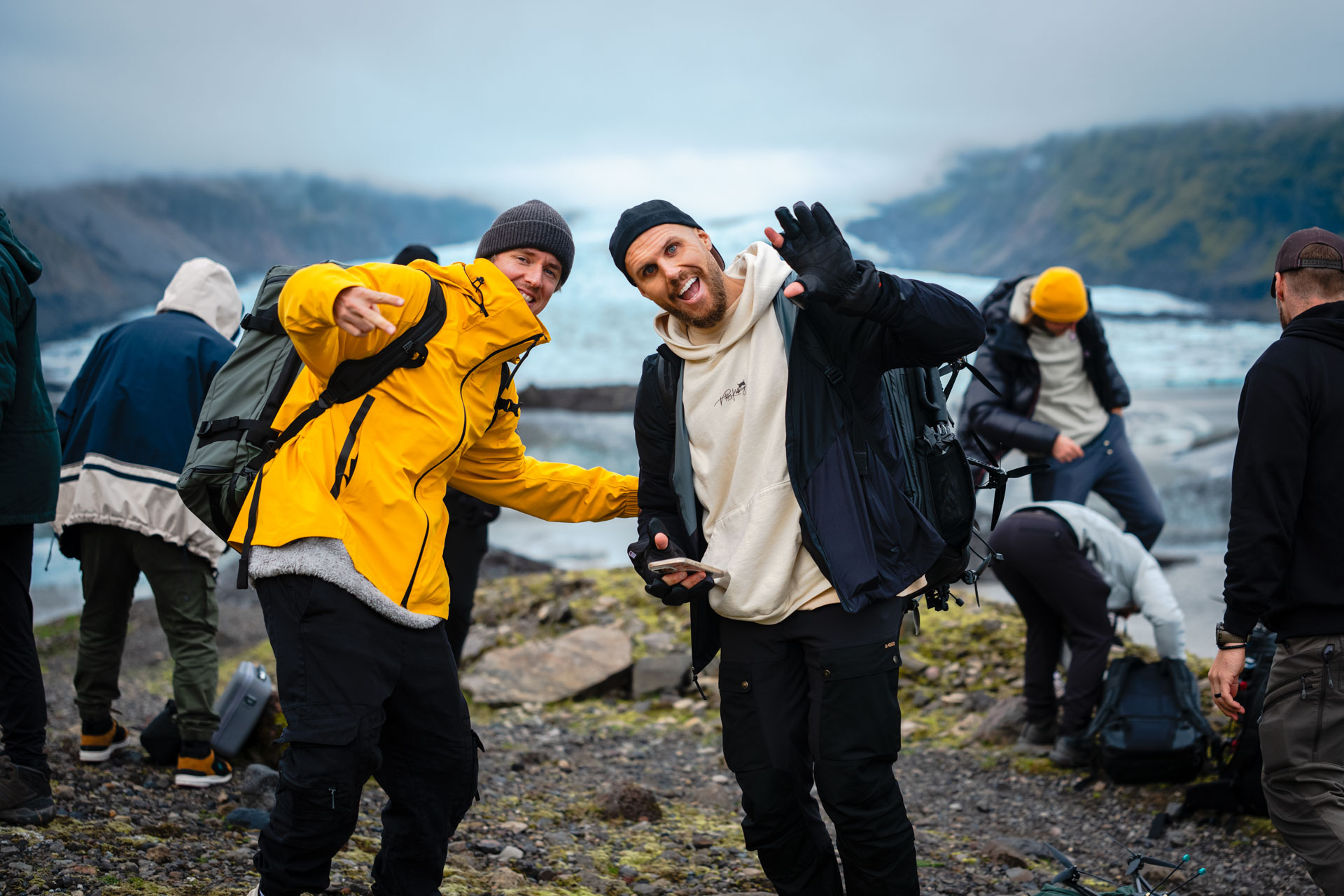Iceland’s otherworldly landscapes, from glaciers to volcanoes and black sand beaches, make it a paradise for drone enthusiasts. But with great beauty comes great responsibility and that begs the question, can i fly a drone in iceland? — the short answer is YES! The long answer is, it depends:
Flying a drone in Iceland requires careful adherence to regulations to protect its unique environment and ensure public safety. This guide provides a comprehensive overview of drone laws, restricted areas, permit requirements, and the consequences of non-compliance, helping you fly your drone responsibly.
We understand that these laws, regulations, and restrictions can be extremely complicated for the average traveler who simply wants to fly their drone. That’s why we handle all the necessary permits, guide you through Icelandic drone laws, and, most importantly, take you to the best drone spots around Iceland. With our assistance, you can fly your drones stress-free and with expert guidance.
Disclaimer
The information in this article is based on official sources and reflects the best knowledge available at the time of writing. However, drone laws, regulations, and restrictions are subject to change. Readers are strongly encouraged to verify the latest rules and requirements relevant to their circumstances with Icelandic authorities or official agencies before planning their flights. If any information is incorrect or outdated please contact us here.

Drone Laws in Iceland
Drone operations in Iceland are regulated by the Icelandic transport authority and Local Government, with rules introduced in December 2017 to ensure the safety of airspace and protect citizens and the environment. These laws apply to all drones flying in Icelandic airspace, with some exceptions for lightweight models.
For drones under 250 grams, some regulations do not apply. However, heavier drones must adhere to stricter rules. Every drone, regardless of its weight, must display identification that includes the operator’s name, address, and phone number. This ensures accountability in case of incidents.
Commercial drone operators are subject to even more stringent requirements. Drones used for professional purposes, including research, must be registered with the Icelandic Transport Authority. Additionally, drone flights cannot exceed an altitude of 120 meters unless the operator has obtained a special permit. These permits are very stringent and come with insurances, heavy planning and generally reserved for commercial purposes, meaning recreational users are typically limited to lower altitudes.

Flying near airports is also heavily restricted. Around international airports, drones are banned within 2 kilometers of the airport boundary. For smaller airports with scheduled domestic services, the restriction is 1.5 kilometers. These rules aim to prevent collisions with manned aircraft, which could have catastrophic consequences.
Respecting privacy and the natural environment is another cornerstone of Iceland’s drone laws. Operators must avoid disturbing people, animals, or property, particularly in sensitive areas like nesting sites or popular tourist locations. Drones should never be flown close to cliffs with nesting birds, especially during the nesting season, as this could disturb the fragile ecosystem.
General Drone Guidelines in Iceland
To ensure a safe and responsible drone flying experience in Iceland, adhere to these general guidelines:
- Altitude Limit: Do not exceed 120 meters (393 feet) in altitude unless you have a special permit.
- Distance from Crowds: Maintain a minimum of 50 meters (164 feet) distance from people, animals, buildings, and vehicles.
- Airport Zones: Avoid flying within 2 kilometers (1.20 miles) of international airports and 1.5 kilometers (0.9 miles) of smaller domestic airports.
- Line of Sight: Keep your drone within your line of sight at all times during operation.
- Weather Conditions: Avoid flying in adverse weather conditions, such as strong winds, heavy rain, or snow.
- Wildlife Protection: Refrain from flying near cliffs or nesting areas, especially during bird nesting seasons (April–August).
- No-Fly Zones: Check for restricted airspace on maps before flying. Use apps like DJI’s no-fly zone alerts for guidance.
Here you can read more about the Icelandic drone laws at the official website.
By following these guidelines, you can minimize risks and ensure compliance with Icelandic drone laws.
Registration and EASA
In line with updated EU regulations, new laws in Iceland require all drone operators to register on flydrone.is and pay a registration fee. All drones must now be labeled with the operator’s phone number. Operators of drones over 250 grams must pass a competency test and obtain a certificate.
Drone activities are categorized into three risk-based groups:
- Open Category: Low-risk operations with specific subcategories (A1, A2, A3).
- Specific Category: Medium-risk requiring a permit.
- Certified Category: High-risk, demanding operator and drone certification.

Where Can I Fly and Where Can I Not Fly?
Flying a drone in Iceland is not as simple as finding an open space and launching. The country’s commitment to preserving its environment and protecting its visitors means that restrictions vary depending on location, season, and even the purpose of the flight.
In general, you are allowed to fly drones in open areas, provided you do not fly over crowds and maintain a safe distance from people, animals, and structures. However, areas within national parks and near protected wildlife are governed by stricter rules.
National Parks and Protected Areas
Iceland’s national parks—Vatnajökull, Þingvellir, and Snæfellsjökull—have specific regulations regarding drone use. For example, in Vatnajökull National Park, drones for commercial use are not permitted without a prior permit and has restrictions for recreational use. This park is home to sensitive environments, including glaciers and wildlife habitats, where drone activity could cause disturbances. Similarly, in Þingvellir National Park, permits are required for commercial use, and restrictions apply for recreational flights.
Snæfellsjökull National Park has additional seasonal restrictions. From mid-April to mid-September, drones cannot be flown without explicit permission from the Environmental Agency of Iceland. These months coincide with nesting seasons for many bird species, making it crucial to avoid disturbing wildlife. Outside the nesting season, drone operations are permitted under strict conditions to minimize environmental impact. We will discuss permits further in a section below.

Popular Tourist Sites
Many iconic locations in Iceland, such as the Látrarbjarg, Lundey and Dyrhólaey, are highly sensitive to drone activity. While drones are technically allowed in some of these areas, operators are often required to obtain permits, especially if the drone is used for commercial purposes.
Here you can see a full list of popular tourist sites and AND RESTRICTIONS from the environmental agency in Iceland. Restrictions are regularly updated so we recommend double checking their site before you fly.
List of restricted places
- Akurey
- Andakíll
- Bessastaðanes
- Blikastaðakró – Leiruvogur
- Búrfell, Búrfellsgjá og Selgjá
- Drangar
- Dverghamrar
- Dynjandi
- Dyrhólaey
- Flatey
- Friðland að Fjallbaki
- Friðland við Fitjá
- Gerpissvæðið
- Geysir
- Glerárdalur
- Goðafoss
- Gullfoss
- Hlið
- Hornstrandir
- Hólmanes
- Ingólfshöfði
- Conservation area north of Dyrfjalla as well as Stórurð
- Lundey
- Skógafoss
- Snæfellsjökull National Park
- The coastline of Stapi and Hellnar
- Surtsey
- Þjórsárdalur (Gjáin, Háifoss, Granni and Hjálparfoss)
- Urriðakotshraun
- Varmárósar

What Spots Do I Need a Permit For?
Permits are generally required for flying drones in all national parks, protected areas, and locations with high environmental sensitivity.
National Parks
In Vatnajökull National Park, you will need to file an application with the park’s administration to obtain a permit for commercial use. For recreational use special terms and restrictions apply, read more about restrictions of vatnajökull national park here.
Similarly, in Þingvellir National Park, obtaining a permit is mandatory for commercial use and is done through this page. For recriational use, the process is similar to Vatnajökull National Park, and you must ensure compliance with all restrictions to minimize disruption to the park’s pristine environment. The restrictions for recriational use are that you cannot fly a drone between 09:00 and 18:00. Read more about drone flight for personal use here.
For Snæfellsjökull National Park, restrictions apply from 15th April to 15th September and must be approved by the Environmental Agency of Iceland. Drones are not allowed unless authorized. No permits are issued for flights near bird cliffs during nesting seasons. You can apply here.
Tourist Attractions
Some of Iceland’s most visited attractions also require permits. Please refer to the list above for possible need for a permit. You can apply here.

How to Get a Permit
The process for obtaining a permit varies depending on the location and the purpose of the drone flight. For general flights exceeding 120 meters, you will need to apply through the Icelandic Transport Authority (Samgöngustofa). This application typically involves providing information about the drone’s registration, the operator’s qualifications, and the intended flight area and many other, this permit asks for a lot of planning and cost. You can apply here.
For flights in national parks or protected areas, permits are handled by the Environmental Agency of Iceland. These permits require detailed information about the proposed flight and its purpose, whether recreational or commercial. Permit costs vary significantly: commercial operators pay higher fees.
What Happens If I Break the Law?
Breaking drone laws in Iceland can lead to significant penalties. Authorities take violations seriously, particularly those that endanger wildlife or disturb the natural environment.
If caught flying a drone in a restricted area without a permit, you could face hefty fines and/or imprisonment of up to 2 years.
Legal action is also possible for more severe violations, particularly if your actions result in damage to property or harm to individuals. For breaking general drone laws are fines and up to 5 year imprisonment as per article 141 on air travel no. 60/1998.

Conclusion
Flying a drone in Iceland offers unparalleled opportunities to capture the country’s stunning landscapes from a unique perspective. However, strict regulations are in place to ensure that these incredible locations are preserved for future generations. By understanding where you can fly, obtaining the necessary permits, and respecting local laws, you can enjoy a safe and rewarding drone-flying experience in one of the world’s most beautiful destinations.
We understand that these laws, regulations, and restrictions can be extremely complicated for the average traveler who simply wants to fly their drone. That’s why we handle all the necessary permits, guide you through Icelandic drone laws, and, most importantly, take you to the best drone spots around Iceland. With our assistance, you can fly your drones stress-free and with expert guidance.
For more information, consult official resources such as the Icelandic Transport Authority and the Environmental Agency of Iceland.



